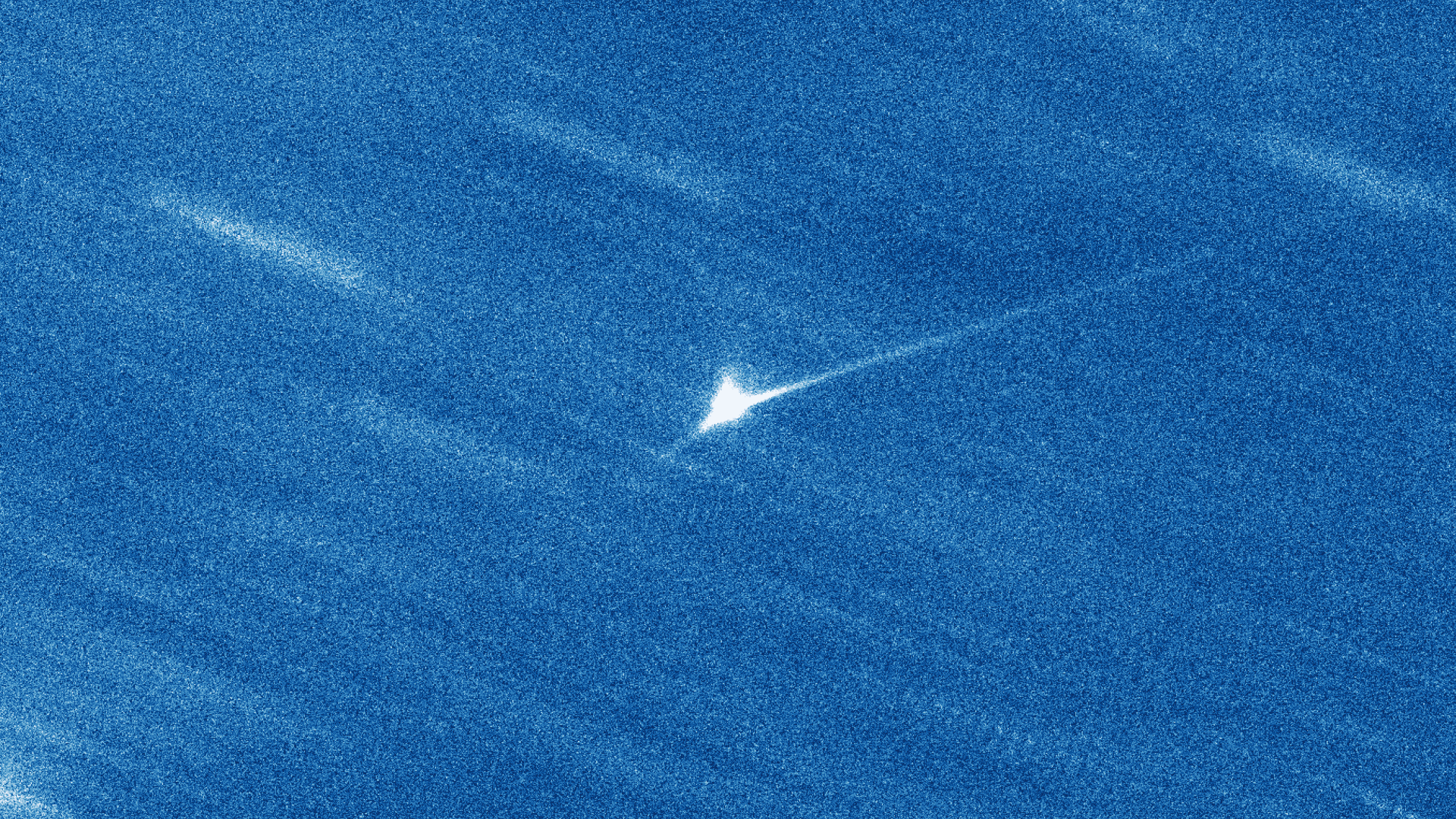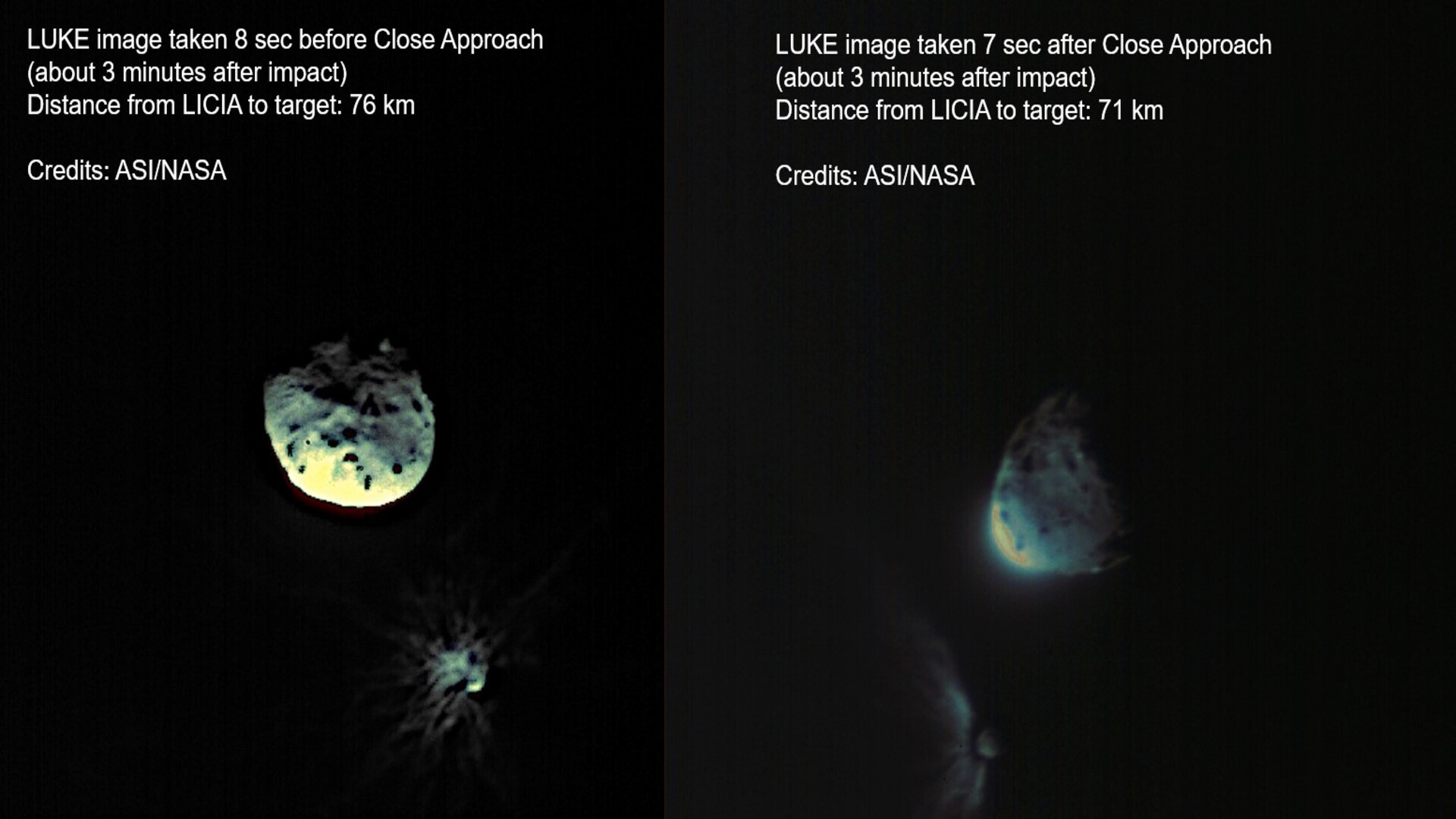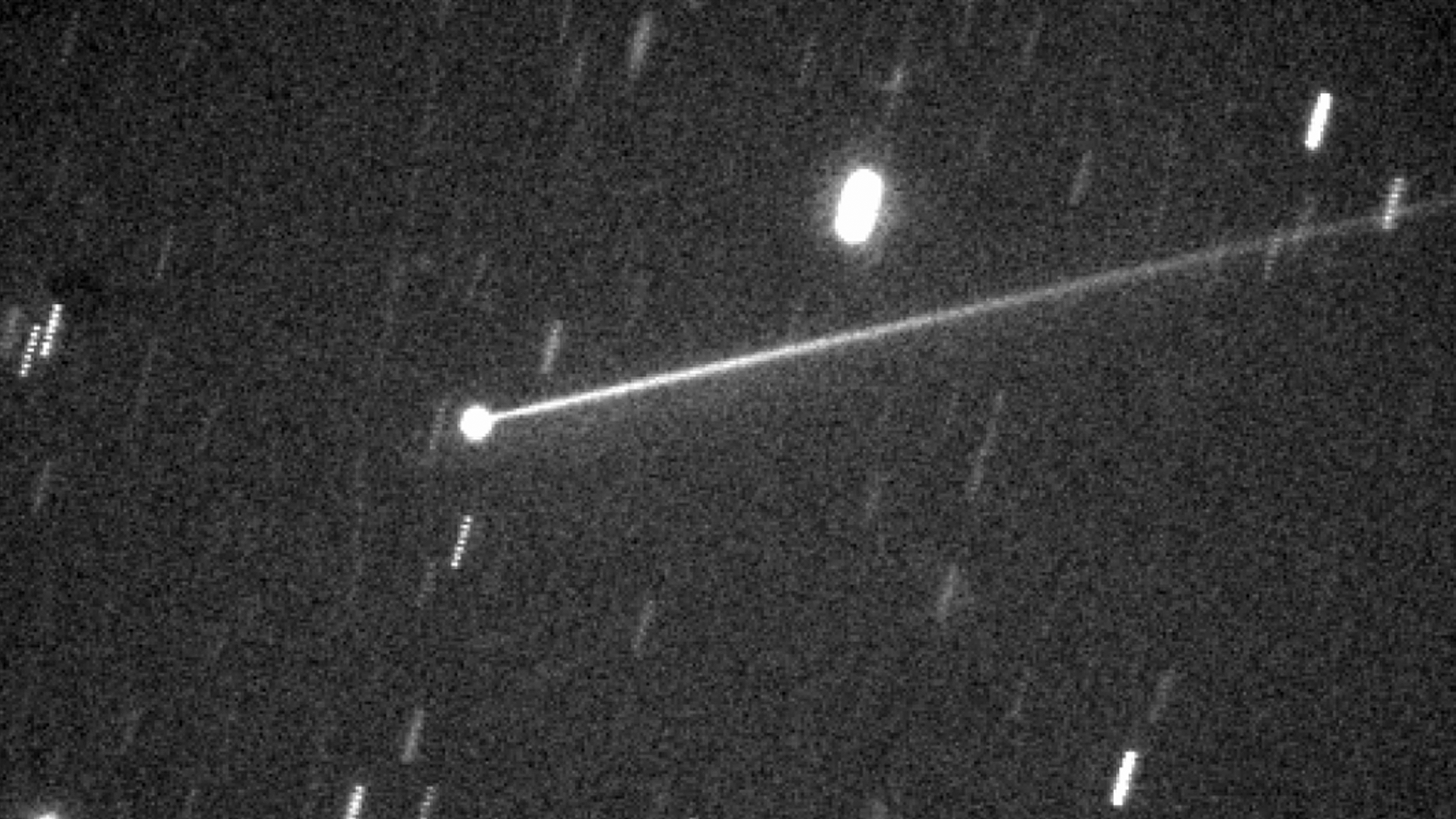NASA's DART asteroid smash flung 2 million pounds of rock into space

The massive tail created by the collision of a spacecraft and an asteroid earlier this year is unlocking key information about space rocks — and how to manage any such rock that may one day threaten Earth.
NASA's Double Asteroid Redirection Test (DART) mission slammed into a small space rock called Dimorphos in late September in preparation for the possibility humans may one day want to deflect an asteroid on a collision course with Earth. Within weeks of the impact, the DART team announced that the impact shaved 32 minutes off Dimorphos' orbit around its larger companion, Didymos — at the high range of the team's prelaunch estimates. Scientists are now sharing additional findings about the impact during the American Geophysical Union's annual conference happening this week in Chicago and online
"DART has been a tremendous success," Tom Stadtler, program scientist for the DART mission, said during a news conference held on Thursday (Dec. 15) in conjunction with the meeting. "I've seen these results, I know that they're extremely cool."
Related: Behold the 1st images of DART's wild asteroid crash!
Many of the new results focus on the stunning, comet-like tail produced by debris from the impact. Mission scientists weren't sure in advance just how much debris DART's collision would create, but the impact did not disappoint.
And scientists had a front-row seat, thanks to the DART spacecraft's Italian hitchhiker, Light Italian Cubesat for Imaging of Asteroids (LICIACube), which was equipped with two cameras and deployed 15 days before DART's impact, allowing it to fly past Dimorphos just three minutes after impact. The tiny spacecraft's photographs show quite a cosmic mess, with clouds of material bursting off the space rock.
"The images were indeed impressive," Alessandro Rossi, LICIACube science team member and a scientist at the Instituto di Fisica Applicata Nella Carrara in Italy, said during the news conference. "We didn't expect some of the features that we see."
Breaking space news, the latest updates on rocket launches, skywatching events and more!
Scientists are still analyzing LICIACube's data, but images captured by its two cameras can offer a sense of how large certain debris is, how fast it's traveling, and more, Rossi said. Researchers even think they can see the debris casting a shadow on the larger asteroid Dimorphos orbits, Didymos.
The debris offers a sense of the asteroid's structure, since an asteroid of solid rock would produce much less ejecta than an asteroid made of boulders clumped together — picture bouncing a tennis ball off pavement compared to throwing it into a sandbox.
In addition, the ejecta has solved a key mystery about Dimorphos and Didymos. Scientists suspected that the two space rocks would be made of similar material, but didn't have a way to test that theory, either as the spacecraft sped to its destination or by using ground-based telescopes, none of which are powerful enough to see Dimorphos directly.
Before impact, scientists could use the light they saw from the system to analyze the composition of the pair of space rocks overall, knowing that almost all of that light came from Didymos. But in similar data taken just after the impact, it's the debris flying off Dimorphos that's responsible for most of the light.
Comparing the two light signatures showed that although some slight differences appear, the material seems to be quite similar between the two asteroids. "We're very excited to see that these two objects are in fact similar in composition," Cristina Thomas, a planetary scientist at Northern Arizona University who leads the DART observations working group, said during the news conference.
Scientists will be studying Dimorphos' fresh tail for quite a while, including digging deeper into observations taken in the days following the collision, gathering new data to see how the plume changes over time, and comparing observations from different vantage points.
"We have a vision of the ejecta plume from close by, we have a vision from the ground, we have the vision from Hubble Space Telescope, from the James Webb Space Telescope," Rossi said. "So we have a lot of different geometries to compare with, and this is allowing us to clearly characterize the ejecta plume from many points of view."
Crunching the numbers
During the news conference, scientists also shared two key numbers they have calculated since the collision.
First, they've begun estimating how much debris flew off the asteroid: at least 2.2 million pounds (1 million kilograms), and possibly as much as 22 million pounds (10 million kg). Given Dimorphos' total mass of perhaps 11 billion pounds (5 billion kg), the rock could have lost just 0.2% of its material, even if the higher estimate proves correct.
"We're talking about a tiny, tiny fraction," Andy Rivkin, a planetary scientist at the Johns Hopkins Applied Physics Laboratory and co-lead of DART, said in the news conference.
The second number goes to the core of the DART mission's purpose. DART wasn't about seeing inside an asteroid, it was about planetary defense. This involves hunting for asteroids on orbits that intersect with Earth's and calculating whether the two bodies might ever find themselves in the same place at the same time.
If scientists ever spot a sizeable asteroid that poses a real threat, the thinking goes, humans could try to intervene by speeding up the asteroid's orbit around the sun so that it misses its appointment with Earth. DART tested one technique for that, called kinetic impact — a fancy name for hitting the asteroid with a heavy, fast-moving object.
However, scientists don't have a good enough sense of how the characteristics of an asteroid and of a collision could interact to produce a specific change in the rock's momentum in space, making it difficult to know what size spacecraft to launch, for example.
Scientists use a crucial number, called the "momentum transfer factor" or beta, to describe how effective an asteroid impact is. If a spacecraft hits an asteroid head-on in a collision that doesn't produce any debris, the space rock will pick up exactly the momentum the spacecraft had as it crashed, a beta of 1.
A host of characteristics can affect the beta factor — whether the spacecraft hits a smooth patch or a large boulder, for example, the internal structure of the asteroid, and what material the asteroid is made of — but let's set those aside for simplicity's sake.
Debris shooting off the asteroid and into space gives the asteroid additional momentum, gradually increasing the beta factor of the impact. And scientists have now calculated the beta factor of DART's impact at 3.6. That value means that the asteroid picked up more than triple the momentum than it would have in a clean impact, and that the debris created by the impact affected the asteroid even more than the spacecraft itself.
"This is very good news for the kinetic impact technique," Andy Cheng, DART investigation team lead at the Johns Hopkins Applied Physics Laboratory, said during the news conference. "At least in the case of DART, the kinetic impact on the target was really efficient at changing the orbit of the target."
The calculation also gives scientists much-needed real-world data to understand how an asteroid's characteristics affect momentum transfer — data that are crucial for determining just how massive a kinetic impact spacecraft should be to avert catastrophe. DART's successor, the European Space Agency's Hera spacecraft, currently scheduled to launch in 2024, will also play a key role here after it arrives (much more gently) at the asteroid pair to study Dimorphos and Didymos up close.
"Where we're trying to get is to have that ability to observe an asteroid, both from the ground or maybe with a reconnaissance mission, and infer what the response will be if we do deploy a kinetic impactor against it," Stadtler said.
Despite the intriguing findings in terms of both science and planetary defense, the mission team emphasized that they were far from done with the project.
"From here, now, we actually get to get to our dream list, where we can start to think about the really complicated dynamical effects that were predicted, that we weren't sure that we would be able to observe because we'd never done this before," Thomas said. "We are looking forward to more observations that are going to allow us to study things in great detail, and I think that's a really exciting place to be."
Email Meghan Bartels at mbartels@space.com or follow her on Twitter @meghanbartels. Follow us on Twitter @Spacedotcom and on Facebook.

Meghan is a senior writer at Space.com and has more than five years' experience as a science journalist based in New York City. She joined Space.com in July 2018, with previous writing published in outlets including Newsweek and Audubon. Meghan earned an MA in science journalism from New York University and a BA in classics from Georgetown University, and in her free time she enjoys reading and visiting museums. Follow her on Twitter at @meghanbartels.


